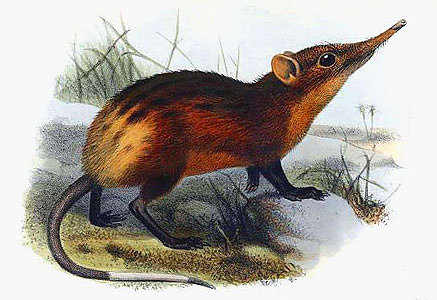- Golden-rumped Elephant Shrew
Taxobox
name = Golden-rumped Elephant Shrew

image_width = 240px
status = EN
status_system = iucn3.1
trend = down
regnum =Animal ia
phylum = Chordata
classis =Mammal ia
ordo =Macroscelidea
familia =Macroscelididae
genus = "Rhynchocyon "
species = "R. chrysopygus"
binomial = "Rhynchocyon chrysopygus"
binomial_authority = Günther,1881 The Golden-rumped Elephant Shrew ("Rhynchocyon chrysopygus") is the largest of the African
elephant shrew family. It is the size of a small rabbit, and is only found in the coastalArabuko Sokoke National Park north ofMombassa inKenya . Its name is derived from the conspicuous golden fur on its hindquarters which contrasts strongly with its otherwise dark fur. On juveniles its fur shows vestigal traces of the checkerboard pattern seen on another giant elephant shrew, theCheckered Elephant Shrew ("Rhynchocyon cirnei").The Golden-rumped Elephant Shrew lives on the forest floor of evergreen forests, rooting through the leaf litter for 80% of the waking day looking for
grasshopper s,beetle s,spider s and other small invertebrates.The Golden-rumped Elephant Shrew has evolved various stratagems to avoid predators, particularly snakes (like
Black Mamba s andcobra s) and theSouthern Banded Snake-eagle . It is very fast, capable of running at 25km/h. In the event of it detecting a predator within its 'flight distance' it will bound off. If, however, the predator is outside its flight distance the elephant shrew will advertise its presence by slapping the leaf litter. This lets the predator know that it has been seen and it should not waste its time chasing the elephant shrew. In the event of a chase, or an ambush, the golden flash of fur will also often deflect the predators attention away from the head and onto the rump, which has thickened skin. As a final precaution each shrew has several nests which it maintains, thus a predator finding a nest will not learn to associate them with potential food.Conservation
The Golden-rumped Elephant Shrew is classified as endangered because of its highly restricted and fragmented environment; it is also hunted for food and by feral dogs.
The Golden-rumped Elephant Shrew was identified as one of the top-10 "focal species" in 2007 by the Evolutionarily Distinct and Globally Endangered (EDGE) project. [Cite news | title = Protection for 'weirdest' species | url = http://news.bbc.co.uk/2/hi/science/nature/6263331.stm | date = 2007-01-16 | accessdate = 2007-05-22 | work =
BBC ] EDGE identifies species that are evolutionarily distinct and need better protection to prevent extinction. The Golden-rumped Elephant Shrew was placed in the top-10 along withAttenborough's Long-beaked Echidna ,Hispaniolan Solenodon ,Bactrian Camel ,Yangtze River Dolphin ,Slender Loris ,Hirola ,Pygmy Hippo ,Bumblebee Bat , and theLong-eared Jerboa .Cite web | url = http://www.edgeofexistence.org/species/species_info.asp?id=21 | title = Hexaprotodon liberiensis | work =EDGE Species | accessdate = 2007-07-31]References
* [http://news.bbc.co.uk/2/hi/science/nature/6263331.stm News story about the Evolutionarily Distinct and Globally Endangered project (EDGE)]
* Database entry includes justification for why this species is endangered
* The Kingdom Field Guide to African Mammals "by" Jonathan Kingdom,1997 ; ISBN 0-7136-6513-0
* The New Encyclopedia of Mammals, "edited by" David Macdonald, Oxford University Press,2001 ; ISBN 0-19-850823-9
*External links
* EDGE of Existence [http://www.edgeofexistence.org/species/species_info.asp?id=46 "(Rhynchocyon chrysopygus)"] - Saving the World's most Evolutionarily Distinct and Globally Endangered (EDGE) species
* ARKive - [http://www.arkive.org/species/GES/mammals/Rhynchocyon_chrysopygus/ images and movies of the golden-rumped elephant shrew "(Rhynchocyon chrysopygus)"]
Wikimedia Foundation. 2010.
